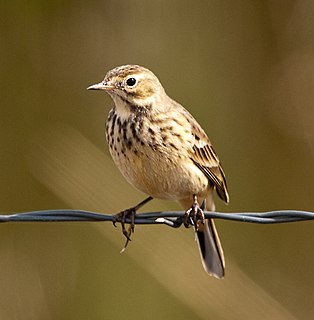
Pseudomonas is a genus of Gram-negative, Gammaproteobacteria, belonging to the family Pseudomonadaceae and containing 191 validly described species. The members of the genus demonstrate a great deal of metabolic diversity and consequently are able to colonize a wide range of niches. Their ease of culture in vitro and availability of an increasing number of Pseudomonas strain genome sequences has made the genus an excellent focus for scientific research; the best studied species include P. aeruginosa in its role as an opportunistic human pathogen, the plant pathogen P. syringae, the soil bacterium P. putida, and the plant growth-promoting P. fluorescens, P. lini, P. migulae, and P. graminis.

The buff-bellied pipit, or American pipit as it is known in North America, is a small songbird found on both sides of the northern Pacific. It was first described by Marmaduke Tunstall in his 1771 Ornithologia Britannica. It was formerly classified as a form of the water pipit.

Pseudomonas fluorescens is a common Gram-negative, rod-shaped bacterium. It belongs to the Pseudomonas genus; 16S rRNA analysis as well as phylogenomic analysis has placed P. fluorescens in the P. fluorescens group within the genus, to which it lends its name.

The curry tree is a tropical to sub-tropical tree in the family Rutaceae, and is native to Asia. The plant is also sometimes called sweet neem, though M. koenigii is in a different family to neem, Azadirachta indica, which is in the related family Meliaceae.
Pseudomonas putida is a Gram-negative, rod-shaped, saprotrophic soil bacterium.

The Pseudomonadaceae are a family of bacteria which includes the genera Azomonas, Azorhizophilus, Azotobacter, Mesophilobacter, Pseudomonas, and Rugamonas. The family Azotobacteraceae was recently reclassified into this family.

Cystovirus is a genus of double-stranded RNA viruses which infects Pseudomonas bacteria. It is the only genus in the family Cystoviridae. The name of the group cysto derives from Greek kystis which means bladder or sack. There are currently seven species in this genus, including the type species Pseudomonas virus phi6.

Pseudomonas aeruginosa is a common encapsulated, Gram-negative, rod-shaped bacterium that can cause disease in plants and animals, including humans. A species of considerable medical importance, P. aeruginosa is a multidrug resistant pathogen recognized for its ubiquity, its intrinsically advanced antibiotic resistance mechanisms, and its association with serious illnesses – hospital-acquired infections such as ventilator-associated pneumonia and various sepsis syndromes.

Bonny Light oil is found at Oloibiri in the Niger delta region of Nigeria in 1956 for its first commercial use. Since then, indigenous people in Nigeria used it as medical treatment, detox, dermal inflammation, digestive disorders, and so on. Due to its features of generating high profit, it has high demand in refiners. Bonny light oit has an API of 32.9, classified as light oil. It is regarded as more valuable than the other oils with lower API as more high-value products are produced in the refinement. However, in Nigeria, problems due to oil spillage causes vandalism and affects both human and ecosystem in detrimental ways. Some experiments on animals and soil are done to figure out those impacts on organisms.

The blusher is the common name for several closely related species of the genus Amanita. A. rubescens, found in Europe and eastern North America, and A. novinupta in western North America. Both their scientific and common names are derived from the propensity of their flesh to turn pink on bruising, or cutting.
Carvacrol, or cymophenol, C6H3(CH3)(OH)C3H7, is a monoterpenoid phenol. It has a characteristic pungent, warm odor of oregano.

Burkholderia cepacia complex (BCC), or simply Burkholderia cepacia, is a group of catalase-producing, lactose-nonfermenting, Gram-negative bacteria composed of at least 20 different species, including B. cepacia, B. multivorans, B. cenocepacia, B. vietnamiensis, B. stabilis, B. ambifaria, B. dolosa, B. anthina, B. pyrrocinia and B. ubonensis. B. cepacia is an opportunistic human pathogen that most often causes pneumonia in immunocompromised individuals with underlying lung disease. Patients with sickle-cell haemoglobinopathies are also at risk. The species complex also attacks young onion and tobacco plants, and displays a remarkable ability to digest oil.
4-Hydroxybenzoic acid, also known as p-hydroxybenzoic acid (PHBA), is a monohydroxybenzoic acid, a phenolic derivative of benzoic acid. It is a white crystalline solid that is slightly soluble in water and chloroform but more soluble in polar organic solvents such as alcohols and acetone. 4-Hydroxybenzoic acid is primarily known as the basis for the preparation of its esters, known as parabens, which are used as preservatives in cosmetics and some ophthalmic solutions. It is isomeric with 2-hydroxybenzoic acid, known as salicylic acid, a precursor to aspirin, and with 3-hydroxybenzoic acid.
The European White Elm cultivar Ulmus laevis 'Colorans' was listed as U. effusa var. colorans by Kirchner in Petzold & Kirchner, Arboretum Muscaviense (1864).

Ananda Mohan Chakrabarty, Ph.D. was an Indian American microbiologist, scientist, and researcher, most notable for his work in directed evolution and his role in developing a genetically engineered organism using plasmid transfer while working at GE, the patent for which led to landmark Supreme Court case, Diamond v. Chakrabarty.
Biosurfactant usually refers to surfactants of microbial origin. Most of the bio-surfactants produced by microbes are synthesized extracellularly and many microbes are known to produce bio-surfactants in large relative quantities. Some are of commercial interest.

In enzymology, a carnitine 3-dehydrogenase (EC 1.1.1.108) is an enzyme that catalyzes the chemical reaction
Pseudomonas infection refers to a disease caused by one of the species of the genus Pseudomonas.
Green nails may be (1) due to a Pseudomonas aeruginosa infection causing a green nail syndrome or (2) the result of copper in tap water.

Rhodamnia rubescens, the scrub stringybark, brush turpentine, or brown malletwood, is an evergreen rainforest tree of the myrtle family Myrtaceae, that is native to Eastern Australia. Identified by a stringy type of bark and triple-veined leaves, it grows in a variety of different rainforests from the Batemans Bay region of southeastern New South Wales to Gympie in southeastern Queensland. It is not seen in the cool temperate rainforests. The pathogen myrtle rust threatens the existence of Rhodamnia rubescens.











